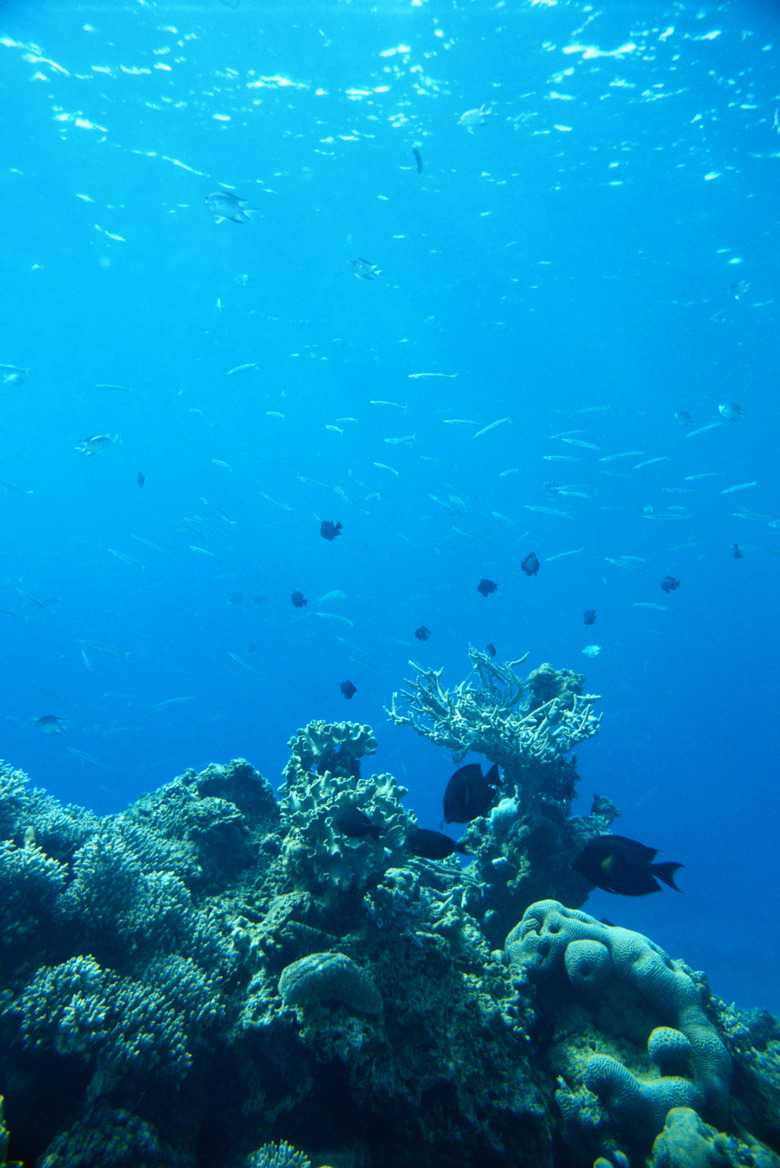Where Does Photosynthesis Take Place In The Ocean?
Just like plants on land, ocean-going plankton need light from the sun to prosper and grow. But light is absorbed by ocean water — and some colors of light are absorbed more readily than others. The deeper you go, the less light is available, and below a certain depth the ocean is completely dark. That's why nearly all photosynthesis in the ocean takes place in the sunlit upper layers. The amount of photosynthetic activity varies with location as well.
Light and Nutrients
Light and Nutrients
The first key requirement for photosynthetic activity is light. Ocean water absorbs light, so light availability decreases exponentially with depth. Below about 200 meters or 650 feet, there's not enough light for photosynthesis to take place. Nutrients are another critical requirement. Nutrient availability varies with both depth and location. In some ocean waters, nutrients are available closer to the surface, and this is where most photosynthesis takes place. In other locations, surface waters are nutrient-poor, and in these areas, most photosynthetic activity takes place in the narrow layer of water where light and nutrient availability overlap.
Depth
Depth
The amount of photosynthetic activity roughly follows a bell-shaped curve. As you go down from the surface, it increases, reaches a peak, then falls off again. The depth where you reach peak photosynthetic activity varies with your location and the season. In polar and many coastal waters, for example, most photosynthetic activity occurs very close to the surface, whereas in equatorial regions photosynthetic activity peaks at about 50 meters, or 160 feet, below the surface in winter and another 25 meters, or 80 feet, further down in spring.
Latitude
Latitude
All regions of the ocean may look alike at first glance, but there are actually many important variations with both season and location that determine how much photosynthetic activity takes place. In the polar regions, surface and deep waters are well-mixed, so nutrients are readily available year round, but very little light is available in the long, dark winter. Consequently, polar waters experience an intense burst of photosynthetic activity in the summer and very little photosynthetic activity in the winter. In the tropics, water tends to stay stratified and little mixing of deep and surface water takes place. Consequently, photosynthesis in these areas is low because nutrient availability is limited, but is fairly constant throughout the year because of more stable light levels.
Location
Location
Regardless of latitude, the amount of photosynthetic activity per square mile is much lower in the open ocean than in coastal waters or on continental shelves, because coastal waters have a much more abundant supply of nutrients. The highest rates of photosynthetic activity per square mile occur in estuaries and shallow coastal waters. Nonetheless, the open oceans still account for a greater share of total photosynthetic activity because they occupy much more space. Over 90 percent of the ocean surface area is open ocean.
Cite This Article
MLA
Brennan, John. "Where Does Photosynthesis Take Place In The Ocean?" sciencing.com, https://www.sciencing.com/photosynthesis-place-ocean-5104/. 24 April 2017.
APA
Brennan, John. (2017, April 24). Where Does Photosynthesis Take Place In The Ocean?. sciencing.com. Retrieved from https://www.sciencing.com/photosynthesis-place-ocean-5104/
Chicago
Brennan, John. Where Does Photosynthesis Take Place In The Ocean? last modified March 24, 2022. https://www.sciencing.com/photosynthesis-place-ocean-5104/
